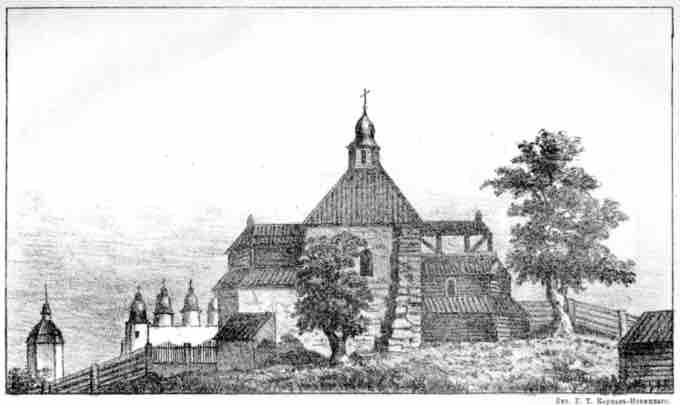Vladimir I
Vladimir I, also known as Vladimir the Great or Vladimir Sviatoslavich the Great, ruled Kievan Rus' from 980 to 1015 and is famous for Christianizing this territory during his reign. Before he gained the throne in 980, he had been the Prince of Novgorod while his father, Sviatoslav of the Rurik Dynasty, ruled over Kiev. During his rule as the Prince of Novgorod in the 970s, and by the time Vladimir claimed power after his father's death, he had consolidated power between modern-day Ukraine and the Baltic Sea. He also successfully bolstered his frontiers against incursions from Bulgarian, Baltic, and Eastern nomads during his reign.
Early Myths of Christianization
The original Rus' territory was comprised of hundreds of small towns and regions, each with its own beliefs and religious practices. Many of these practices were based on pagan and localized traditions. The first mention of any attempts to bring Christianity to Rus' appears around 860. The Byzantine Patriarch Photius penned a letter in the year 867 that described the Rus' region right after the Rus'-Byzantine War of 860. According to Photius, the people of the region appeared enthusiastic about the new religion and he claims to have sent a bishop to convert the population. However, this low-ranking official did not successfully convert the population of Rus' and it would take another twenty years before a significant change in religious practices would come about.
The stories regarding these first Byzantine missions to Rus' during the 860s vary greatly and there is no official record to substantiate the claims of the Byzantine patriarchs. Any local people in small villages who embraced Christian practices would have had to contend with fears of change from their neighbors.
Vladimir I and His Rise to Power
The major player in the Christianization of the Rus' world is traditionally considered Vladimir I. He was born in 958, the youngest of three sons, to the Rus' king Sviatoslav. He ascended to the position of Prince of Novgorod around 969 while his oldest brother, Yaropolk, became the designated heir to the throne in Kiev. Sviatoslav died in 972, leaving behind a fragile political scene among his three sons. Vladimir was forced to flee to Scandinavia in 976 after Yaropolk murdered their brother Oleg and violently took control of Rus'.
Vladimir I
A Christian representation of Vladimir I, who was the first Rus' leader to officially bring Christianity to the region.
Vladimir fled to his kinsman Haakon Sigurdsson, who ruled Norway at the time. Together they gathered an army with the intent to regain control of Rus' and establish Vladimir as the ruler. In 978, Vladimir returned to Kievan Rus' and successfully recaptured the territory. He also slew his brother Yaropolk in Kiev in the name of treason and, in turn, became the ruler of all of Kievan Rus'.
Constantinople and Conversion
Vladimir spent the next decade expanding his holdings, bolstering his military might, and establishing stronger borders against outside invasions. He also remained a practicing pagan during these first years of his rule. He continued to build shrines to pagan gods, traveled with multiple wives and concubines, and most likely continued to promote the worship of the thunder god Perun. However, the Primary Chronicle (one of the few written documents about this time) states that in 987 Vladimir decided to send envoys to investigate the various religions neighboring Kievan Rus'.
According to the limited documentation from the time, the envoys that came back from Constantinople reported that the festivities and the presence of God in the Christian Orthodox faith were more beautiful than anything they had ever seen, convincing Vladimir of his future religion.
Another version of events claims that Basil II of Byzantine needed a military and political ally in the face of a local uprising near Constantinople. In this version of the story, Vladimir demanded a royal marriage in return for his military help. He also announced he would Christianize Kievan Rus' if he was offered a desirable marriage tie. In either version of events, Vladimir vied for the hand of Anna, the sister of the ruling Byzantine emperor, Basil II. In order to marry her he was baptized in the Orthodox faith with the name Basil, a nod to his future brother-in-law.

17th-century Church of the Tithes
The original stone Church of the Tithes collapsed from fire and sacking in the 12th century. However, two later versions were erected and destroyed in the 17th and 19th centuries.
He returned to Kiev with his bride in 988 and proceeded to destroy all pagan temples and monuments. He also built the first stone church in Kiev named the Church of the Tithes starting in 989. These moves confirmed a deep political alliance between the Byzantine Empire and Rus' for years to come.
Baptism of Kiev
On his return in 988, Vladimir baptized his twelve sons and many boyars in official recognition of the new faith. He also sent out a message to all residents of Kiev, both rich and poor, to appear at the Dnieper River the following day. The next day the residents of Kiev who appeared were baptized in the river while Orthodox priests prayed. This event became known as the Baptism of Kiev.
Monument of Saint Vladimir in Kiev
This statue sits close to the site of the original Baptism of Kiev.
Pagan uprisings continued throughout Kievan Rus' for at least another century. Many local populations violently rejected the new religion and a particularly brutal uprising occurred in Novgorod in 1071. However, Vladimir became a symbol of the Russian Orthodox religion, and when he died in 1015 his body parts were distributed throughout the country to serve as holy relics.